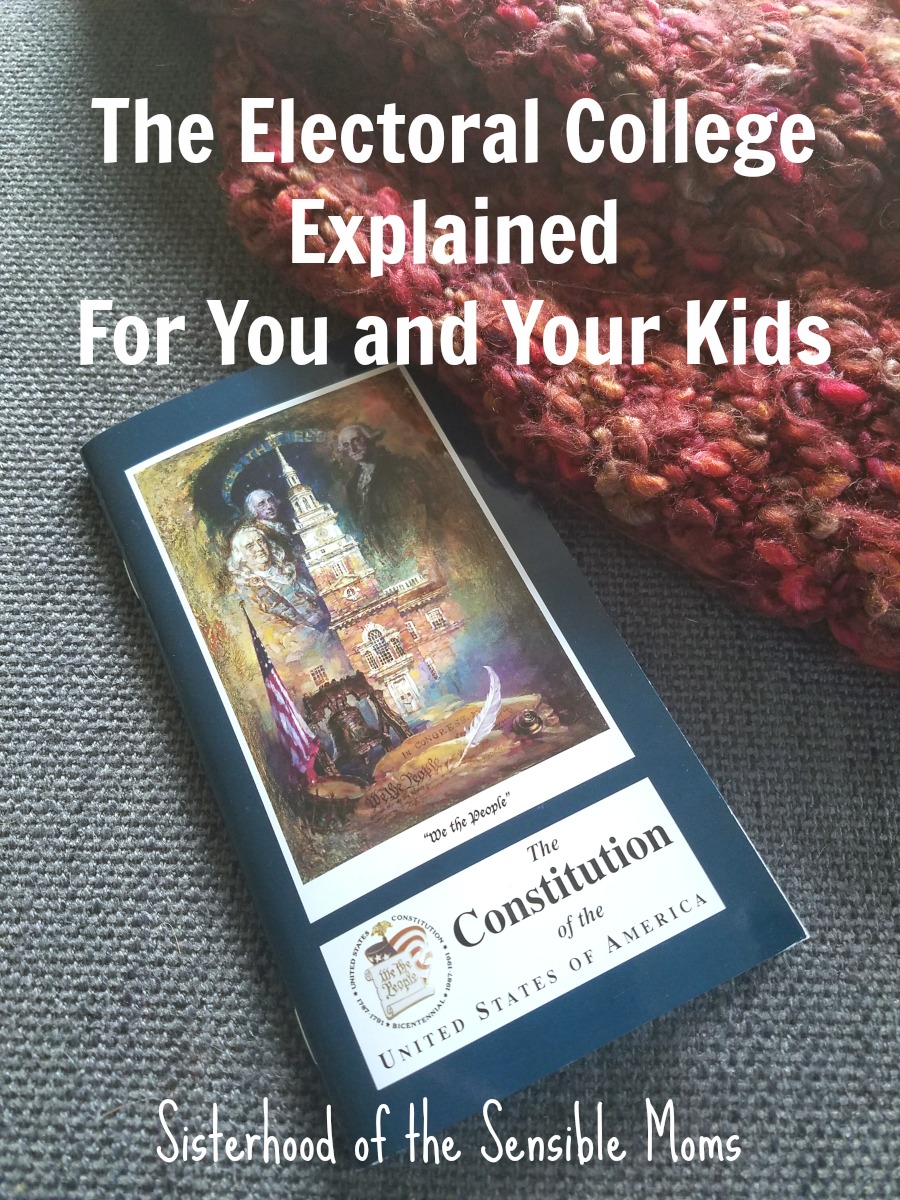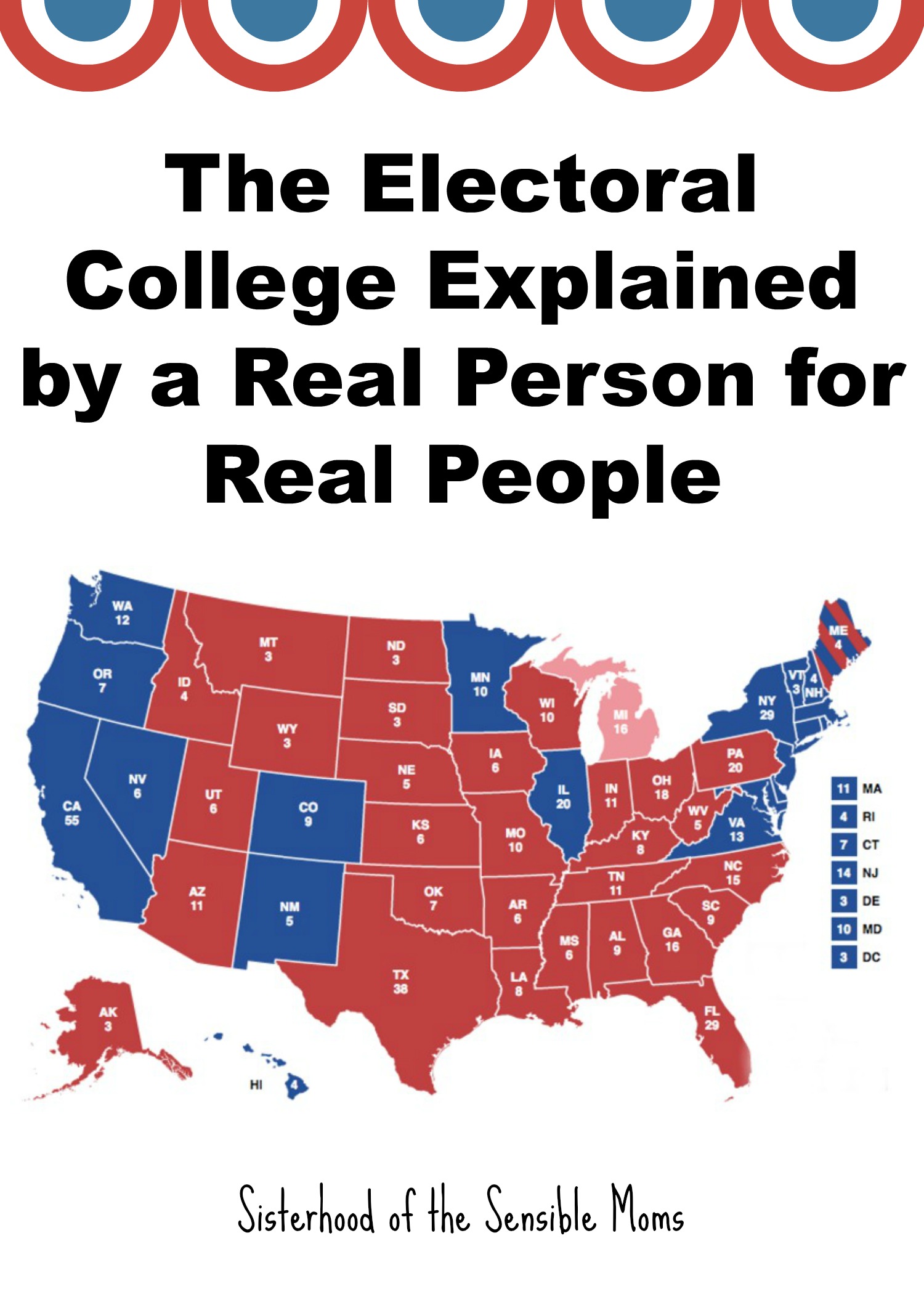
Every four years it’s like a civics lesson all over again: What the heck is the Electoral College? Wait, that’s not accurate. We only truly care we are not actually voting for a president—but for a slate of electors—when the popular vote does not jive with the electoral college votes . . . like it did in 2000 (Bush winning over Gore) and 2016 (Trump winning over Clinton). The Electoral College/popular vote disharmony happened in 1876 and 1888, too.
Since Clinton supporters are petitioning electors “to ignore their states’ votes and cast their ballots for [former] Secretary Clinton,” and I have these pesky offspring who ask questions that matter, I have found myself delving for hours through the internet, books, and ::gasp:: the Constitution. Yes, the ACTUAL Constitution printed on ACTUAL paper. This post is born out of the desire to not wash, rinse, and repeat this research when my youngest is able to vote in her first presidential election in 2020 because spoiler alert, I’m pretty sure the Electoral College will still be a thing.
The Basics of the Electoral College
There are 538 electors (one elector equals one vote), and a candidate must win 270 votes to become President. The number of electors for each state is determined by its congressional delegation: the number of Representatives in the House plus the two Senators. So, for my home state of Maryland that makes 10.
Such an unwieldy filter for direct democracy must be mandated pretty clearly in the Constitution, right? Nope. Different states choose their electors in different ways. Some states have nominations for electors during party conventions, while others choose their electors in primaries. It’s a hodgepodge free-for-all. The only two things that can really disqualify you from being an elector is holding a federal office or having engaged in some sort of insurrection against the U.S. government. In general, electors are loyal party members who can be counted on to cast a ballot that’s in line with their state’s popular vote.
However, only 29 out of 50 states, and the District of Columbia, have passed laws binding their electors to vote in accordance with the popular vote in their state. (Doing the math, that means there are 21 states where no such law is present at all.) Yep, the most powerful position in our country is really meted out on a wave of tradition. So what happens if an elector breaks rank? Uh, they get a fine, get called a “faithless elector,” and sometimes . . . become a folk hero. In 1972, Roger MacBride, the treasurer of the Republican Party of Virginia, was a pledged elector for Richard Nixon and Spiro Agnew. Instead he voted for the Libertarian candidate. That little move got him the Libertarian party presidential nomination in the 1976 election. There have been others who have broken rank, but it has never really made a difference.
In general though, the electoral votes in each state are allotted to the candidate who nabbed the popular vote there in a winner-take-all scenario . . . but there are special snowflake exceptions. Those crazy kids, Nebraska and Maine, decided to let each congressional district determine its own candidate while still awarding 2 electoral votes to the state winner (these account for the 2 electoral votes given to each state because of Senators). Although Maine and Nebraska have been using this system since 1972 and 1992, respectively, split votes have only happened once for each state. Nebraska’s electoral vote was split in 2008 with Barack Obama carrying a congressional district centered around Omaha, and his Republican rival, John McCain gaining the state’s other four votes. This year’s election marks the first time that Maine will split its electoral votes with one of its four votes going to Trump. It’s didn’t make much of a difference in either election, but maybe this split vote thing could make a difference in states with a greater number of electoral votes?
So when are these votes cast? Right after the election would make the most sense since we have the news outlets telling us who won the election by 2 am, but nay, nay. The chosen electors all meet at their respective state capitals on the first Monday after the second Wednesday in December to cast their votes. (Seriously.) The votes are then counted in a joint session of Congress on January 6. Yeah, and the Inauguration is held on January 20th (20th Amendment), so by all appearances it is just for pomp and circumstance.
Why We Have the Electoral College
Since it seems like the Electoral College is just a bunch of curlicues and flourishes and is the very definition of “extra,” why do we have it?
The easy answer is that while we often throw around the word democracy, the United States is actually a representative republic because the creators of the Constitution valued federalism—meaning that power is divided between our federal government and our state and local governments. So in the most idealistic terms, the Electoral College was supposed to prevent a power grab by a tyrannical majority. Alexander Hamilton indicated in “The Federalist Papers” that the point of the Electoral College was to preserve “the sense of the people,” while at the same time ensuring that a president was chosen “by men most capable of analyzing the qualities adapted to the station, and acting under circumstances favorable to deliberation, and to a judicious combination of all the reasons and inducements which were proper to govern their choice.”
So that’s the very verbose ideal, but while the end product of our government’s creation is pretty amazing, it was founded by real men with real prejudices and real self-interests. In 1787, at the Philadelphia Convention (where the Constitution was created to replace the Articles of Confederation), the Pennsylvanian, James Wilson, proposed direct national election of the president.
However, James Madison figured out that in a direct election system, the North would outnumber the South, whose many slaves (more than half a million in all) could not vote. The Three-Fifths Compromise was enacted to count each male slave as three-fifths of a person to determine representation in the U.S. House, and consequentially a state’s number of electoral votes. Of course the only “representation” was of pro-slavery interests since slaves were still not allowed to vote. (Did they actually listen to themselves?) States were basically rewarded for the number of slaves they bought and bred. Because of the Three-Fifths Compromise, for 32 of the Constitution’s first 36 years, a white slave-holding Virginian occupied the presidency. (The 14th Amendment, ratified in 1868, abolished the three-fifths rule and granted (male) former slaves the right to vote.)
The Electoral College Was Almost Immediately Obsolete
So it seems obvious that a system birthed out of political slight of hand to gain advantage by abusing the rights of human beings might not be something we need today? Heck, before we exited the 19th century, the Electoral College became a clunker. The 12th Amendment establishing the Electoral College was ratified in 1804. So let’s just consider the noble reasons for it, and assume it was developed to prevent “the tyranny of the majority” and because people across the vast United States would lack information to make intelligent decisions when choosing a president. It was around the same time of the 12th Amendment ratification that our two party system began to emerge providing more balance to prevent tyranny, and effectively tying presidential candidates to state and local governments. The development of standard political platforms meant “the people” would know who and what they were voting for.
So Why Do We Still Have It?
All pros and cons aside, the biggest reason we still have it is that it would take a Constitutional Amendment to change it. After including the whole “Alcohol is illegal! Nope, it’s legal again!” in the (18th and 21st) amendments of the founding document of our government, constitutional amendments are a hard sell because we are thankfully a bit more discerning now. (It literally takes an act of Congress, see below.)
Another bugaboo is that when the electoral votes don’t reflect the national popular vote, the party in power is the one that benefited from the Electoral College. Yeah.
In a more positive point, there are some analysts who insist that the Electoral College ensures that middle and rural America will not be ignored by presidential candidates, and that urban centers won’t determine elections. They argue it ensures that the President represents everyone.
Then there’s the ever popular “if it ain’t broke, don’t fix it.” Our electoral system has been stable for over 200 years. By all results, the Electoral College has effectively preserved federalism and prevented chaos. That is nothing to sneeze at. Building onto this thought, some believe that the Electoral College supports the power of the states in determining our president and ensures that presidents receive support from a diverse array of people around the country.
But Really . . .
The only “real” argument for why the Electoral College will endure is because it is in the Constitution. It is intentionally difficult to change the Constitution: two-thirds of both the House and Senate would need to vote to repeal it via a Constitutional amendment, AND THEN three-fourths of state legislatures would need to ratify the amendment.
However, there is a loophole to convening a Constitutional Convention: The National Popular Vote Interstate Compact (NPVIC). In a nutshell, the compact is designed to ensure that the candidate who wins the most popular votes is elected president. Several U.S. states and the District of Columbia have adopted the agreement to award all their respective electoral votes to the candidate winning the popular vote. So if you use this election as an example, each state in the NPVIC would award its electoral votes to the winner of the national popular vote—Hillary Clinton—no matter if the state itself went red or blue.
So why is this not happening? Well, only ten states and the District of Columbia have joined for a total of 165 combined electoral votes. You can see a map of which ones have joined here, and by the way, they are all blue states. There needs to be enough states signed on with enough votes to make it to that magical number of majority: 270.
Oh and there is one more litttttttle thing. Even if enough states join, it may require Congressional approval. Article I, Section 10 of the US Constitution states that: “No State shall, without the Consent of Congress . . . enter into any Agreement or Compact with another State, or with a foreign Power. . .” HOWEVER, it is being heavily debated in legal circles whether this article would actually apply to the NPVIC. While the legalities are convoluted, the takeaway is simple: the NPVIC is not an uncomplicated or straight path to circumventing the Electoral College.
Why the Electoral College is an Unnecessary Dinosaur

1. Small states don’t need the protection. First, states with smaller populations receive an unfair “bump” in voting power with the Electoral College, and that goes beyond “protection.” For example, there are 711,723 Californians for every Electoral College vote that state casts in the presidential election, but in Wyoming, there’s one Electoral College vote per 195,369 residents. How does this happen? Because no matter what the population, a state still gets those 2 electoral votes tacked on for its 2 senators.
So what about the argument that urban centers on the coasts would determine the elections without the Electoral College? I disagree. With just a quick look at population numbers (I realize not everyone in the census count can vote, but still, it illustrates the point).
California (38.8 million) plus New York State (19.75 million) equals 58.55 million people.
It only takes 13 red midwest and southern states (Montana, Idaho, Wyoming, Utah, North Dakota, South Dakota, Nebraska, Kansas, Oklahoma, Texas, Arizona, Indiana, and Missouri) to equal a population of 62.27 million. (There were still 17 more red states leftover.)
I’m just not buying that if everyone came out to vote, California and New York would determine the President on their own.
2. Hey, the Senate ensures equality. The less populous states don’t need the 2 senator vote count advantage in the Electoral College (explained above) because they are already getting the advantage in the ACTUAL Senate. Every state gets two votes. Each presidential election year everyone seemingly forgets that the Executive branch functions under the checks and balances of the Legislative and Judiciary branches. Our government is constructed so that our state elections (which are direct, one person equals one vote, 17th Amendment) determines our state’s federal power.
3. The Electoral College can actually diminish the rural voice in an economically diverse state. In my home state of Maryland, every four years, five of the most urban counties determine the winner of our electoral votes. This produces feelings of disenfranchisement where farmers, watermen, and small business owners feel like the city of Baltimore decides who our president is going to be.
5. The Electoral College only acts to draw candidates to swing states. It’s also often argued that candidates would only focus campaign attention on huge states if the Electoral College was eradicated. Well, all the Electoral College ensures is that states split 50/50 between Democrats and Republicans (like Ohio, Pennsylvania, North Carolina, and Florida) get attention. States that are locked into their voting patterns like Texas (red) and New York (blue) get very little campaign attention despite their large number of electoral votes. Candidates ignore where they are hopelessly behind or drastically ahead. Basically, votes in swing states carry more power.
The Main Reason The Electoral College Needs to Go
It creates voter apathy.
Votes are “wasted” under the Electoral College. It doesn’t matter if a candidate wins by 1,000 votes or 600,000 votes in California, they still receive the same the power of its 55 electoral votes. Likewise, every vote for the candidate who doesn’t win the electoral votes goes into the metaphorical garbage.
In Maryland, many of my friends and acquaintances didn’t want Trump or Hillary, but they especially didn’t want Trump. They felt like they could just not vote, thus not supporting Hillary, but knowing Hillary would win our blue state anyway. There had to be Hillary supporters who didn’t vote because they knew it didn’t matter. With or without their votes, Hillary would get out 10 electoral votes. The fact is only 2.37 million people out of 6 million voted in Maryland.
Extrapolate this nationwide. How many people don’t vote because they know how their state is going to go? If more people voted would elections still be cutting it as close as they are now?
The Most Interesting Question I Have Not Seen Asked
If we eliminated the Electoral College would it increase voter turnout?
Only 57.9% of eligible voters cast a ballot in the 2016 election. That left over 90 million votes on the table. Would knowing their personal voices would be heard and not filtered through the Auto-Tune of the Electoral College bring more Americans out to the polls? In our nomadic, global society should our voices be drowned out by the choral “AMEN” of the state we happen to land in or should we all be allowed to sing our own solos? I, for one, would like my off-key soprano to be heard.
-Ellen
References
All website sources used are linked throughout this post.
You can get your own Constitution here for $1.00.
Texts used: Everything You Need to Ace American History in One Big Fat Notebook: The Complete Middle School Study Guide and Prentice Hall’s United States History.
Hey! Want to buy our new book? I Just Want to Be Perfect brings together 37 hilarious and relatable essays that showcase the foibles of ordinary women trying to be perfect.
You can follow us on Google+, Twitter, Facebook, Instagram, and Pinterest.
Check out our books, “I Just Want to Be Alone” and “You Have Lipstick on Your Teeth.”










